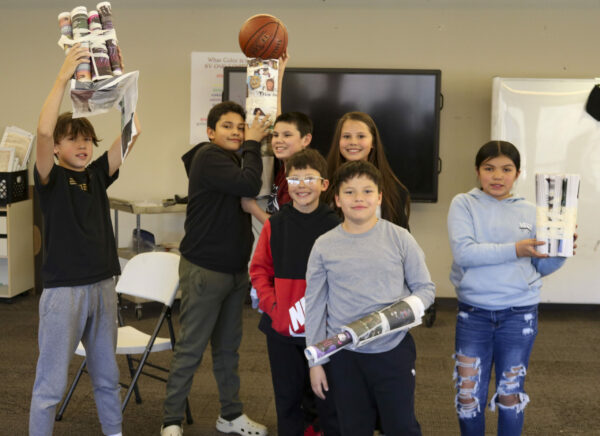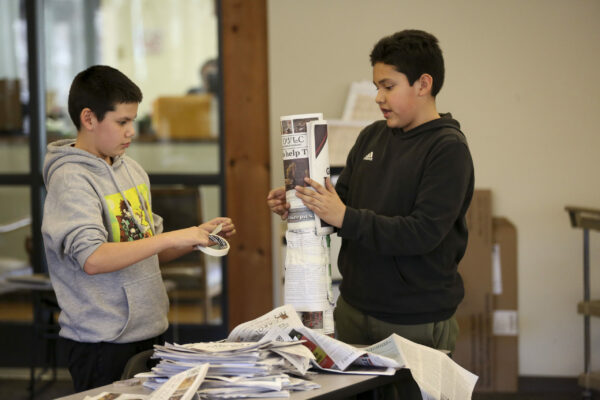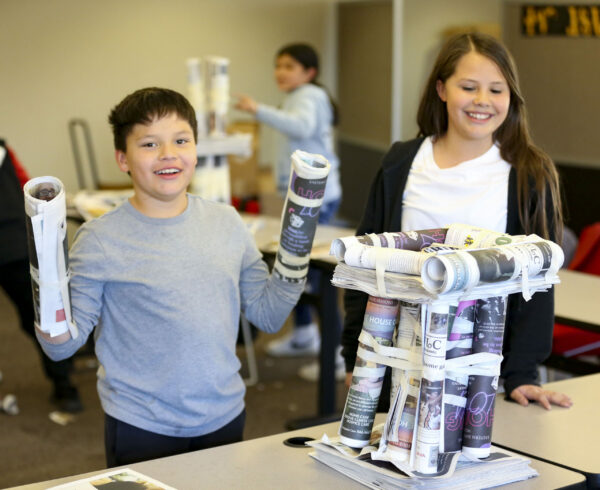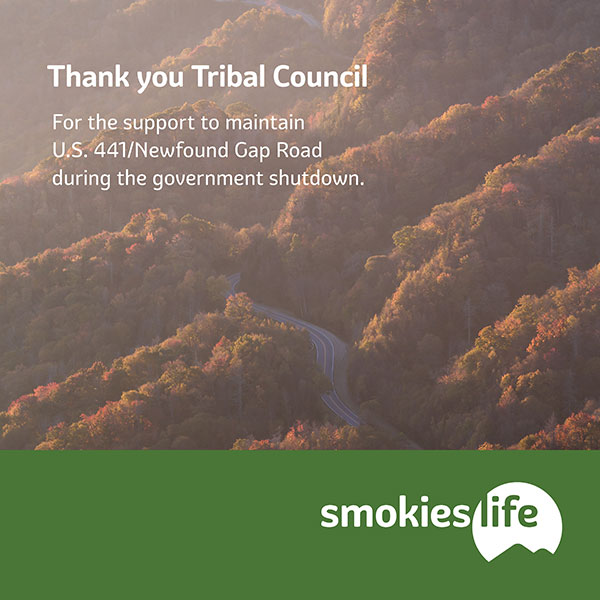By SCOTT MCKIE B.P.
One Feather Asst. Editor
CHEROKEE, N.C. – The activity room of the New Kituwah Academy was abuzz with excitement, energy, and laughter on the afternoon of Wednesday, March 15. The after-school STEM-E Club, consisting of seven fifth- and sixth-grade students, was busy designing and building their latest challenge.
Using newspapers donated by the Cherokee One Feather, the students were divided into three groups and challenged to design and build a tower out of the papers and masking tape that could support the weight of a basketball.

Fifth- and sixth-grade students in the New Kituwah Academy STEM-E Club are shown following a challenge they worked on during their meeting on the afternoon of Wednesday, March 15 at the school. They are shown, left to right, back row – Wayasdi Stephens, Waya Lossiah, Wanei Sneed, Deluge Driver, Tsisdetsi Arch; front row – Ganolegi Driver and Kvli Hernandez. (SCOTT MCKIE B.P./One Feather photo)
The STEM-E (Science, Technology, Engineering, Math, and Entrepreneurship) Club is one of several in schools around western North Carolina that is sponsored by a grant from the Cherokee Preservation Foundation and facilitated by WRESA (Western Region Education Service Alliance) and WNC EdNet (Western North Carolina Education Network). The mission statement of the program is “to stimulate interest in STEM careers and prepare our young people for a global competitive and collaborative workforce”.
Jessica Metz, New Kituwah third and fourth grade teacher of english/language arts, science, and social studies, helps facilitate the club along with Kristin Driver, a New Kituwah fifth and sixth grade math teacher. “It’s a chance for them, usually, to be a little bit more creative than they are in just regular class to do some different kinds of projects. Right now, we’re doing something different every time, but soon we’ll be starting with a more ongoing project.”
She noted that they also adhere to the principles of Indigenous STEM as outlined by AISES (American Indian Science and Engineering Society) as follows: S (Spirit), T (Traditions), E (Elders and Equity), and M (Meaning). On the Club, she noted, “It’s just to learn teamwork, how to work together…so, not only how to work with other human beings, but also the design process, how to solve problems, how to not give up if it doesn’t work. The redesign is something that they are so easy to give up, like a lot of us are…but, getting that persistence going is really important. Eventually, the entrepreneurship part is then eventually looking into a design for something that we could market and sell.”
Metz commented, “We also talk about the Meli and the Muddauber story, which is a perfect, beautiful example of the engineering process. She grabs the mud house and throws it in the river. Then she goes back and sees what the effects are…and it even says in the Kathi Littlejohn version of the story that she works on it for a while and then discovers that she can carry water with it. I love using that to connect as an example of the design process.”

Wanei Sneed and Waya Lossiah work on their tower.
For Wednesday’s challenge, the students had to construct their tower without stacking the paper, and they weren’t allowed to build it against anything. It had to be free-standing. Metz commented, “We looked at water towers and fire towers and the Eiffel Tower and different tower designs so we had a little more background info.”
Katlin Roberts, New Kituwah second grade teacher, helps with the Club and noted its benefits. “In a typical classroom, there are standards that you have to meet. And, a lot of the time Jessica is really good at coming up with fun ways to address those standards. But, this gives them an opportunity to do some fun activities that might not align with the standards, or might not be the same as what they’re doing in the classroom. Also, you’re limited by time constraints in the classroom, so this gives them extra time, again, to do activities that they may not have time to do during the school day.”
She added, “They have assignments where they have to work in groups during the school day. And, because all of our students are Cherokee, and because this is a Cherokee school, and a lot of our social expectations and behavior expectations in the school are rooted in traditional Cherokee values, I really think that it emphasizes and reinforces that concept of ga-du-gi. They have to work together as a learning community to achieve a mutual goal. That translates really well to the classroom whenever they have to do group work or even just learning how to get along with each other and learning how to interact in a good way.”
When asked what he liked about the Club, Waya Lossiah, a student from the Big Y Community, said, “What we get to do when we build stuff. It’s always a surprise. You might have it planned out in your mind but then it might not work out so you have to come up with a new way. That’s fun. I like to listen to how everybody thinks it’s going to work then we figure out a way that it’ll be some of what everybody thinks.”

Kvli Hernandez and Deluge Driver smile as they finish their tower.
Deluge Driver, a student from Stecoah, commented, “I like getting to work with people and building stuff. I like working with the team. We get to work together on stuff, and we just take each other’s ideas and put them all together.”
Tsisdetsi Arch, a student from the Wolftown Community, said, “I like the challenges, working as a team, and getting to be creative.”
Wanei Sneed, a student from the Birdtown Community, said the Club builds teamwork like in sports. “We get to build things and do science. It really inspires us to do teamwork.”





